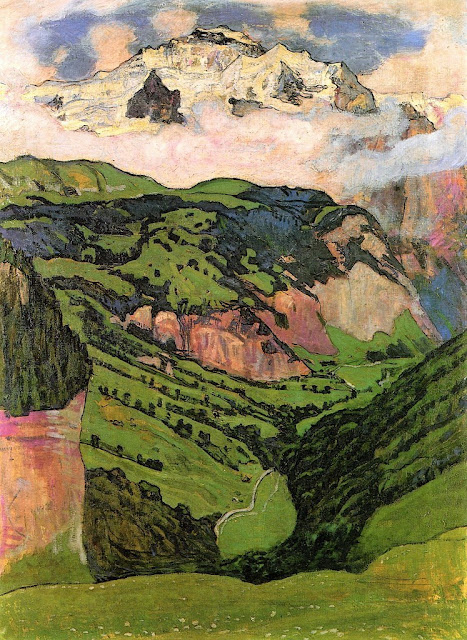NOEL ROOKE (1881-1953)
Les Grandes Jorasses ( 4,208m -13, 806 ft)
France - Italy border
In Les Grandes Jorasses et la Mer de Glace.
The mountain
The Grandes Jorasses (4,208 m - 13,806 ft) is a mountain in the
Mont Blanc massif, on the boundary between Haute-Savoie in France and Aosta Valley in Italy. Les Grandes Jorasses are, simply speaking, the most strikingly complex and powerful structure of the entire Mont Blanc massif. If Mt. Blanc is the king of the Alps, the Grandes Jorasses complex is truly the queen.
The summits on the mountain (from east to west) are:
- Pointe Walker (4,208 m; 13,806 ft), named after Horace Walker, who made the first ascent of the mountain.
- Pointe Whymper (4,184 m; 13,727 ft), he second-highest summit named after Edward Whymper, who made the first ascent.
- Pointe Croz (4,110 m - 13,484 ft), named after Michel Croz, a guide from Chamonix.
- Pointe Elena (4,045 m -13,271 ft), named after Princess Elena of Savoy.
- Pointe Margherita (4,065 m- 13,337),named after Queen Margherita of Savoy, wife of King Umberto I of Italy
- Pointe Young (3,996 m - 13,110 ft) named after Geoffrey Winthrop Young.
The first ascent of the highest peak of the mountain (Pointe Walker) was by Horace Walker with guides Melchior Anderegg, Johann Jaun and Julien Grange on 30 June 1868. The second-highest peak on the mountain (Pointe Whymper )was first climbed by Edward Whymper, Christian Almer, Michel Croz and Franz Biner on June 24, 1865, using what has become the normal route of ascent and the one followed by Walker's party in 1868.
North Face
Located on the French side of the mountain, the north face is one of the three great north faces of the Alps, along with the north faces of the
Eiger and the
Cervin/Matterhorn (known as 'the Trilogy'). One of the most famous walls in the Alps, it towers 1200 m (3,900 ft) above the Leschaux Glacier, stretching 1 km from end to end. The classic route on the face is the Walker Spur (Cassin/Esposito/Tizzoni, 1938, TD+/ED1, IV, 5c/6a, A1, 1200 m) which leads directly to the summit of Pointe Walker. The other major buttress on the mountain is the Croz Spur, which leads to the summit of Pointe Croz. In her solo ascents of the six most difficult north faces of the Alps, Alison Hargreaves chose this route in preference to the Walker Spur.
South face
On the Italian side of the mountain, the south face can be accessed from the Boccalatte cabin, above the hamlet of Planpincieux in the Italian Val Ferret, part of the municipality.
Summit ridge.
From the Col des Hirondelles, the summit ridge connects Pt. Walker to the other summit points and then descends to the Col des Grandes Jorasses where a bivouac shelter is located - the Bivouac E Canzio hut. The ridge forms the French-Italian border, almost all of which is above 4,000 m -13,000 ft).
The artist
Noel Rooke was an English wood engraver and artist. His ideas and teaching made a major contribution to the revival of British wood engraving in the twentieth century. Rooke was born in Acton, in London, where he would remain all of his life. His father was Thomas Matthews Rooke, for many years the studio assistant of Edward Burne-Jones, and an accomplished artist in his own right. He completed his education at the Slade and the Central School of Arts and Crafts.
In 1920 Rooke helped to found the Society of Wood Engravers and exhibited with the society from 1920-1933. In the same year he became an associate of the Royal Society of Painter-Etchers and Engravers. As a result of his teaching, his own production was comparatively small - wood engraved, line drawn and watercolour illustrations, individual prints, posters and paintings, many of which reflect his passion for mountains. He described himself as one who draws mountains and also climbs them. Margaret Pilkington remembers classes where Rooke dwelt on the dramatic contrasts of dark rock and snow covered sunlit slopes, on the angularity of line and on the possibilities of abstraction presented by such scenes.
He produced colour plates for two books by Robert Louis Stevenson -
An Inland Voyage (1908) and
Travels with a Donkey in the Cevennes (1909) - and a King Penguin book on
Flowers of Marsh and Stream (1946). The final judgement on Rooke as a wood engraver goes to Douglas Percy Bliss, who wrote of Vivien Gribble and Rooke:
If their work had more verve and vitality they would be among the best book -decorators of our time.

%20Il%20Lago%20Blu,%20Breuil-Cervinia,%20Val%20d%E2%80%99Aosta,%20Italy.%20(The%20Matterhorn%20seen%20from%20Cervinia)%20oil%20on%20canvas,%20100%20x%20140%20cm.-%20courtesy%20John%20Mitchell%20Fine%20paintings%20.png)













-%20The%20mattherhorn%20from%20%20Riffelsee-%20John%20Mitchell%20gallery%20London%20.png)
